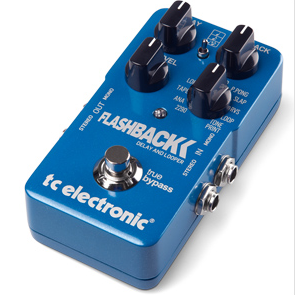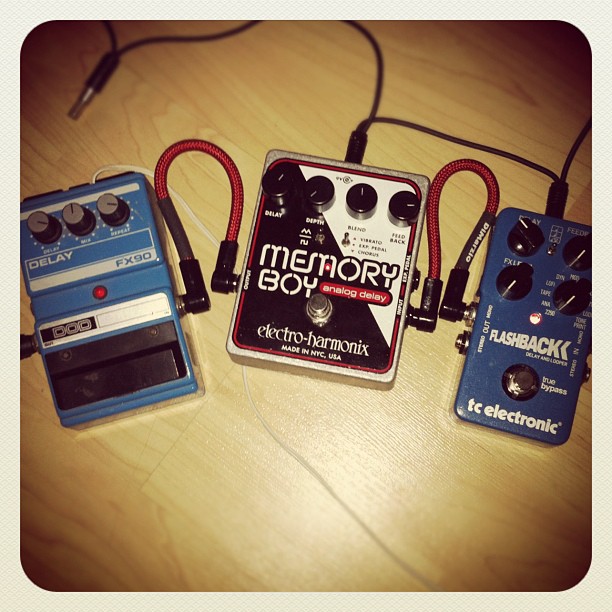 Overview
Overview
The TC Electronic Flashback is a digital delay pedal with 9 distinct delay styles; a looping function; and Tone Print, an extra mode that can be loaded with downloadable artist preset. The pedal has stereo in/out, buffered or true-bypass and controls for FX level, Decay, feedback and mode plus a 3 way toggle to divide the timing.
The pedal is powered by 9V battery or standard DC pedal power. The bottom of the pedal is removable with one screw revealing the battery compartment and a pair of DIP switches. The first switch activates the buffer circuit which helps keep the signal strength consistent in a large pedal board. The second switch mutes the dry signal for use in a parallel signal chain.
Delay time can be set in two ways. First by using the delay knob, the time range is from 20 ms up to 7 seconds, except in slap mode which goes up to 300ms. Having this very long delay time available takes some getting used to, coming from analog pedals. Basically anything past 12 O’clock will be too long for anything but special effects.
The other way to set tempo is with the unique audio-tap function. Push and hold the bypass button, strum the guitar, lift your foot and the delay is in time. This is a very fast and intuitive way of setting tempo.
The toggle switch takes your delay time from 1/4 notes, to dotted 1/8th notes or 1/4″ + dotted 1/8th. When the pedal is used with dual outputs, most of the modes will have a mono output unless this third toggle position is selected.
Examples
All examples are played through Fender Aerodyne Telecaster into the pedal, into Hi-Z input of Profire 2626, then into Amplitube 3 for amp and room sound.
The first mode on the dial is 2290, a digital delay based on the old TC 2290 effect. The manual says there’s no filtering happening in this mode but I’m sure there is at least a little because it doesn’t repeat infinitely like a clean plugin delay would, it thins out and the volume drops for each repeat.
Here’s how that sounds.
[audio:http://audiogeekzine.com/wp-content/uploads/flashback/flashback_2290.mp3|titles=Flashback 2290]
The next mode is the Analog emulation. High frequencies are rolled off in the feedback loop. This mode sounds fairly close to my Electro-Harmonix Memory Boy analog delay in some settings but doesn’t have the full analog delay experience. I will compare this to some real analog delays towards the end of the review.
Here is how the analog mode sounds
[audio:http://audiogeekzine.com/wp-content/uploads/flashback/flashback_ana.mp3|titles=Flashback Analog]
Next up is Tape mode, this mode has some high and low filtering and a more aggressive sound than the Analog mode but still has the same kind of vibe. It sounds kind of like a tape delay but it’s missing something really important.
Here’s how it sounds.
[audio:http://audiogeekzine.com/wp-content/uploads/flashback/flashback_tape.mp3|titles=Flashback Tape]
LOFI mode is a less clean sounding delay and is somewhere between the 2290 and analog mode in sound.
[audio:http://audiogeekzine.com/wp-content/uploads/flashback/flashback_lofi.mp3|titles=Flashback LoFi]
The Dynamic Delay mode is pretty interesting, while you are playing the echoes are aggressively ducked down in level, when you stop the delays come up in level. For certain patterns this is a really cool effect. Besides the ducking, the actual delays decay in one of the nicest ways.
[audio:http://audiogeekzine.com/wp-content/uploads/flashback/flashback_dyn.mp3|titles=Flashback Dynamic]
MOD mode adds vibrato to the delay repeats, keeping the direct sound unaffected. This is a different result than using a chorus pedal after the delay. This mode sounds dramatically different from the others.
[audio:http://audiogeekzine.com/wp-content/uploads/flashback/flashback_mod.mp3|titles=Flashback Modulated]
Ping Pong mode repeats 1/4 notes in the left and right outputs alternately with the original in the center. In mono, every other repeat is lower in level.
[audio:http://audiogeekzine.com/wp-content/uploads/flashback/flashback_ppong.mp3|titles=Flashback Ping-Pong (mono)]
Slap mode is a short delay with fewer repeats. The slap mode is a little too bright sounding for my taste but it doesn’t sound bad. For this kind of effect I’d more likely to use the darker analog or lofi mode.
[audio:http://audiogeekzine.com/wp-content/uploads/flashback/flashback_slap.mp3|titles=Flashback Slapback]
Reverse mode is a fun one. It samples the input and plays it back in reverse. With some settings it even feels like you’re playing backwards.
[audio:http://audiogeekzine.com/wp-content/uploads/flashback/flashback_rvs.mp3|titles=Flashback Reverse]
Looping
The pedal also has a loop mode with up to 40 seconds of mono recording. Switching to this mode drops the input level a little to give you some headroom for overdubs. Hitting the foot switch starts the first recording, click it again to end the loop, it immediately loops playback back the recording. Clicking the footswitch again will add another layer to the recording, as many as you want. Double tapping the footswitch deletes the loop. In this mode delay time and feedback have no effect.
I find the looper to be be a lot of fun, the hard part is making the loop seamless and leaving space for yourself to play over, but after a few tries it becomes easier.
Tone print
Finally, we come to the Tone Print function. Tone Print allows you to store one extra unique type of delay to the pedal. Tone Print files can be downloaded from the TC Electronic website and loaded into the Flashback through a mini USB port, there’s also an iPhone app that uploads the presets through your guitar pickups. The Tone Prints that are available are custom presets that artists have come up with for the pedal and go beyond the preset styles. This is a cool way to expand the functionality of an already great pedal.
Currently there are about 60 Tone Prints for the Flashback, each is a separate download. There isn’t an easy way to get everything and manage tone prints on the computer yet. Because I have 3 tone print pedals, this is a big hassle. It’s so much easier with the iPhone app. Some of the tone prints are really cool and different so it was worth the effort in the end. Hopefully they will streamline the Tone Print function in the near future.
Real Analog Delay Comparison
 I have 3 delay pedals now, I was hoping the Flashback would be all I need but, from an audio geek standpoint, I still need my other pedals just as much as before. In a lot of ways this is more flexible and more useful, on the other hand, it’s missing 2 things that are really important to me.
I have 3 delay pedals now, I was hoping the Flashback would be all I need but, from an audio geek standpoint, I still need my other pedals just as much as before. In a lot of ways this is more flexible and more useful, on the other hand, it’s missing 2 things that are really important to me.
Let’s go back to the analog mode. I said earlier that the analog mode sounds similar to my Memory Boy analog delay, it’s in the ball park but the big problem is that it doesn’t work like an analog delay. Analog and tape delays do two things that the flashback cannot: pitch shifting and glitching when changing delay time, and self-oscillation.
Here’s a comparison of the Flashback in analog mode, a new Electroharmonix Memory Boy analog delay, and vintage DOD FX-90 analog delay. This first comparison is of just tonality with the feedback fairly high.
The next example is changing the delay time during high-feedback repeats. The Flashback just cuts off, the real analog pedals do amazing things!
[audio:http://audiogeekzine.com/wp-content/uploads/flashback/analog_tweaking.mp3|titles=Analog Tweaking]For me this is a problem, and the same thing applies to the tape mode. They should have some chaos to the repeats once the feedback goes past about half way. I did find a Tone Print download that has self-oscillation but it’s not quite the same as the real thing. Turning the delay knob should cause pitch shifting or at least digital glitching. Don’t sell your analog delay pedals just yet.
Final Thoughts
Overall its a great pedal and I’m happy to have it. It’s become my main delay for songwriting and it’s come in handy a few times while mixing. The sound quality, flexibility and expandability of this $149 pedal is outstanding.

@charlie_mcevoy @eclifton123 do you agree with my review? http://t.co/Wyzse2CO
@theaudiogeek Have you checked out Strymon? I have an El Capistan tape echo. Incredible! http://t.co/20Wo7ez7
In case you missed it earlier today, the latest AGZ Review: TC Electronic Flashback Delay Pedal http://t.co/Wyzse2CO
Hey Jon, thought you might enjoy this – a variation of the TC Electronic Flashback delay pedal
http://proguitarshop.com/tc-electronic-alter-ego-delay.html
oops… here’s part 2 of the video:
I reviewed the TC Electronic Flashback Delay pedal on AudioGeekZine yesterday. Check it – http://t.co/lS18rKbS
You can get self-oscillation via the Toneprint editor where you can set Feedback to up to 120%.
A pity about the lack of pitch change when you change the delay time though.
Flashback is a modern spin on the knowledge and also legacy of TC Electronic’s famous 2290 hold-up, including 7 seconds of delay as well as a cherry-picked option of the best hold-up sounds out there. Seriously, why you’re not out buying one now after reading that is past us.